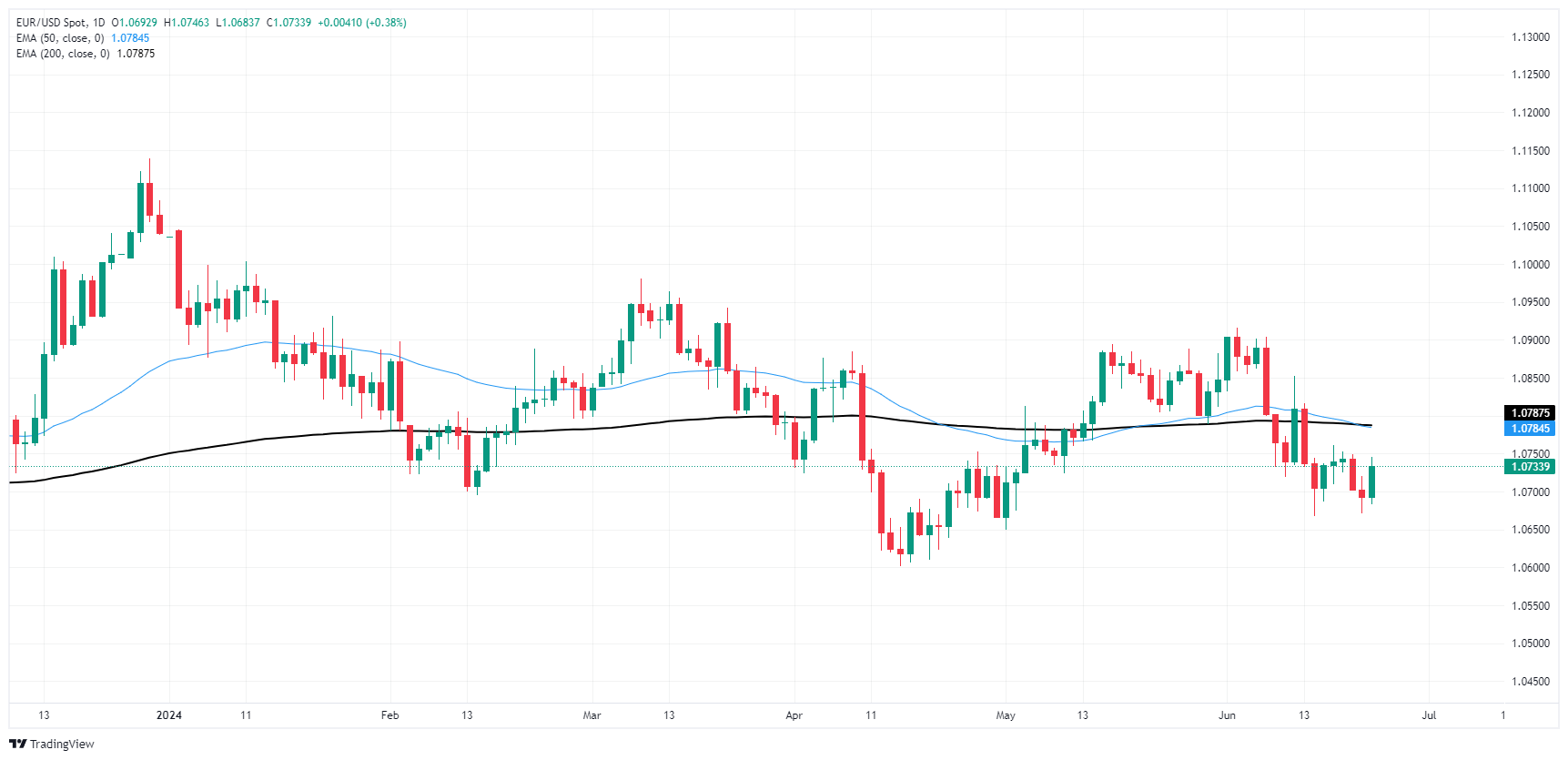- EUR/USD recovered from last week’s downside but remains hung up on 1.0730.
- As USD flows turned lower, Euro traders shrugged off a miss in German data.
- Tuesday restricted to mid-tier releases, and a fistful of central planner speeches.
EUR/USD drifted up in a mild recovery from last Friday’s dip into 1.0670. The new trading week is kicking things off with risk appetite firmly pinned higher, sending the US Dollar lower and bolstering the Euro as investors head into a relatively quiet Tuesday.
Fed's Daly: Inflation is not the only risk, but recent inflation readings are more encouraging
Key economic data releases are relegated to later in the week, leaving traders to focus on statements from policymakers that dot the landscape until meaningful data releases kick off in the back half of the trading week. An update to US Gross Domestic Product (GDP) figures is slated for Thursday, with Friday rounding out the trading week with German Retail Sales and the latest update for US Personal Consumption Expenditure (PCE) Price Index inflation.
Fed's Goolsbee: Slowing inflation data would open door to easier policy
Tuesday’s economic calendar is notably restrained, with an appearance expected from German central bank President Joachim Nagel. During Tuesday's US market session, Federal Reserve (Fed) officials are expected to give several speeches, and central planners will likely lean into middling Fedspeak in echoes of Monday’s performances.
German sentiment surveys broadly missed expectations early Monday, but Euro markets are flaunting downside EU figures to follow the broader market higher as risk appetite continues to pin to hopes of at least a quarter-point cut from the Federal Open Market Committee’s (FOMC) September 18 rate call. According to the CME’s FedWatch Tool, rate traders are pricing in around 70% odds of a 25 basis point rate trim from the Fed in September.
EUR/USD technical outlook
EUR/USD pulled higher after walking back last Friday’s dip into 1.0670, but bullish momentum hit a snag after intraday bids got hung up on the 200-hour Exponential Moving Average (EMA) at 1.0737. EUR/USD still remains on the low side on daily candles, with price action trading on the bearish side of the 200-day EMA at 1.0815.
EUR/USD hourly chart
EUR/USD daily chart
Euro FAQs
The Euro is the currency for the 20 European Union countries that belong to the Eurozone. It is the second most heavily traded currency in the world behind the US Dollar. In 2022, it accounted for 31% of all foreign exchange transactions, with an average daily turnover of over $2.2 trillion a day. EUR/USD is the most heavily traded currency pair in the world, accounting for an estimated 30% off all transactions, followed by EUR/JPY (4%), EUR/GBP (3%) and EUR/AUD (2%).
The European Central Bank (ECB) in Frankfurt, Germany, is the reserve bank for the Eurozone. The ECB sets interest rates and manages monetary policy. The ECB’s primary mandate is to maintain price stability, which means either controlling inflation or stimulating growth. Its primary tool is the raising or lowering of interest rates. Relatively high interest rates – or the expectation of higher rates – will usually benefit the Euro and vice versa. The ECB Governing Council makes monetary policy decisions at meetings held eight times a year. Decisions are made by heads of the Eurozone national banks and six permanent members, including the President of the ECB, Christine Lagarde.
Eurozone inflation data, measured by the Harmonized Index of Consumer Prices (HICP), is an important econometric for the Euro. If inflation rises more than expected, especially if above the ECB’s 2% target, it obliges the ECB to raise interest rates to bring it back under control. Relatively high interest rates compared to its counterparts will usually benefit the Euro, as it makes the region more attractive as a place for global investors to park their money.
Data releases gauge the health of the economy and can impact on the Euro. Indicators such as GDP, Manufacturing and Services PMIs, employment, and consumer sentiment surveys can all influence the direction of the single currency. A strong economy is good for the Euro. Not only does it attract more foreign investment but it may encourage the ECB to put up interest rates, which will directly strengthen the Euro. Otherwise, if economic data is weak, the Euro is likely to fall. Economic data for the four largest economies in the euro area (Germany, France, Italy and Spain) are especially significant, as they account for 75% of the Eurozone’s economy.
Another significant data release for the Euro is the Trade Balance. This indicator measures the difference between what a country earns from its exports and what it spends on imports over a given period. If a country produces highly sought after exports then its currency will gain in value purely from the extra demand created from foreign buyers seeking to purchase these goods. Therefore, a positive net Trade Balance strengthens a currency and vice versa for a negative balance.
Information on these pages contains forward-looking statements that involve risks and uncertainties. Markets and instruments profiled on this page are for informational purposes only and should not in any way come across as a recommendation to buy or sell in these assets. You should do your own thorough research before making any investment decisions. FXStreet does not in any way guarantee that this information is free from mistakes, errors, or material misstatements. It also does not guarantee that this information is of a timely nature. Investing in Open Markets involves a great deal of risk, including the loss of all or a portion of your investment, as well as emotional distress. All risks, losses and costs associated with investing, including total loss of principal, are your responsibility. The views and opinions expressed in this article are those of the authors and do not necessarily reflect the official policy or position of FXStreet nor its advertisers. The author will not be held responsible for information that is found at the end of links posted on this page.
If not otherwise explicitly mentioned in the body of the article, at the time of writing, the author has no position in any stock mentioned in this article and no business relationship with any company mentioned. The author has not received compensation for writing this article, other than from FXStreet.
FXStreet and the author do not provide personalized recommendations. The author makes no representations as to the accuracy, completeness, or suitability of this information. FXStreet and the author will not be liable for any errors, omissions or any losses, injuries or damages arising from this information and its display or use. Errors and omissions excepted.
The author and FXStreet are not registered investment advisors and nothing in this article is intended to be investment advice.
Recommended content
Editors’ Picks

EUR/USD retests daily lows near 1.0850 on softer US PPI
EUR/USD remains on the defensive against the backdrop of another positive day in the US Dollar, always amid intense tariff jitters and weaker-than-expected US Producer Prices in February.

Gold looks bid and trades close to $2,950
Gold extends its winning streak, moving toward the $2,950 mark after notching gains over the past two sessions. Heightened fears of an economic downturn, spurred by escalating trade tensions, have fueled a risk-off environment—further boosting the allure of the precious metal as a safe-haven asset.

GBP/USD remains offered near 1.2940 on USD buying
The continuation of the buying interest in the Greenback keeps the risk complex under pressure, motivating GBP/USD to recede to the 1.2940 region and reverse two consecutive days of gains for the time being.

Metaverse narrative stalls as price action fades, but on-chain data signals continuing accumulation
Metaverse tokens are cryptocurrencies associated with virtual worlds, digital economies, and immersive online experiences. Tokens like Sandbox, Decentraland, and Axie Infinity, three of the most prominent assets during the Metaverse boom of 2021, continue to face correction since they topped in early December.

Brexit revisited: Why closer UK-EU ties won’t lessen Britain’s squeezed public finances
The UK government desperately needs higher economic growth as it grapples with spending cuts and potential tax rises later this year. A reset of UK-EU economic ties would help, and sweeping changes are becoming more likely.

The Best brokers to trade EUR/USD
SPONSORED Discover the top brokers for trading EUR/USD in 2025. Our list features brokers with competitive spreads, fast execution, and powerful platforms. Whether you're a beginner or an expert, find the right partner to navigate the dynamic Forex market.